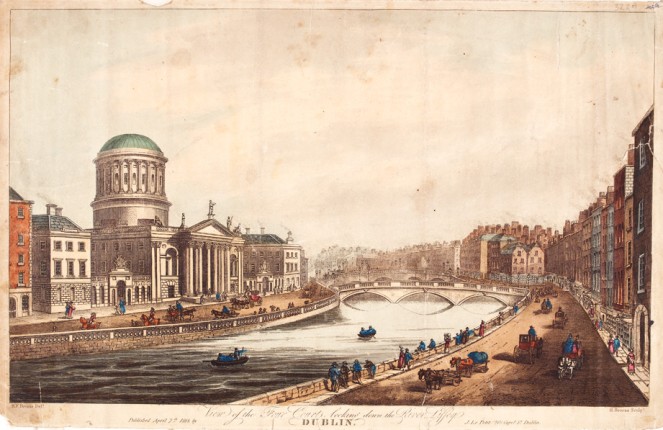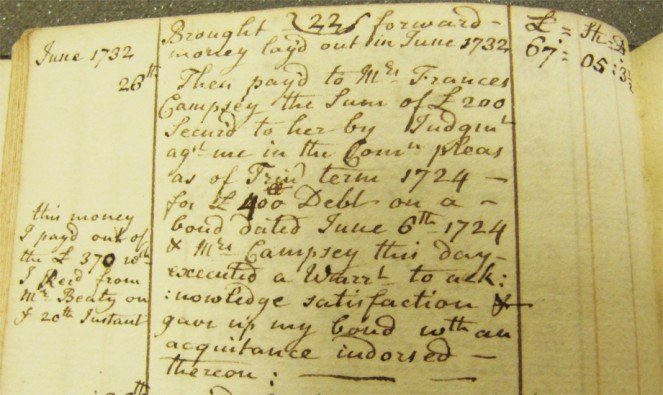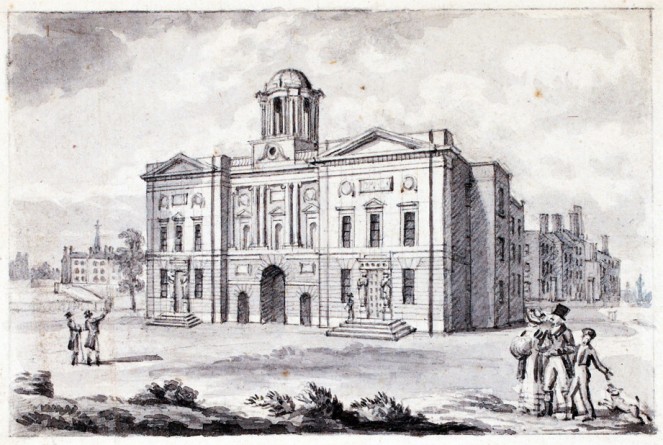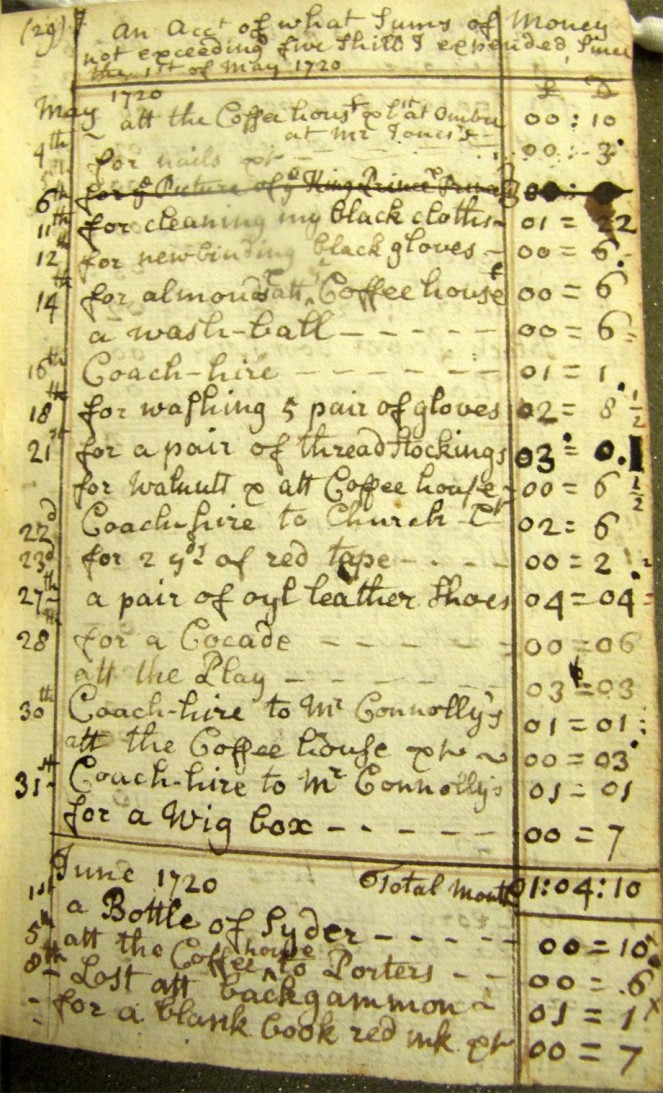by Sean Smith, Researcher at our "Palace to Procrastination"
Lawyers and the legal profession, where would we be without them? If it wasn’t for them we wouldn’t have Dickens’ Bleak House and the interminable case of Jarndyce v Jarndyce. We wouldn’t have the on-going, lengthy and costly tribunals and we wouldn’t have the colourful carnival of wigs, gowns and tipstaffs to brighten even the most tedious of proceedings in the Four Courts. However, while the legal profession has given us some lively entertainment it has also been accused of overcharging, duplicity and of being a cosy old boys' club – keen to keep access to the bar in the hands of a privileged few.

Hand coloured print etching showing four prominent figures on Dublin's legal scene. On the wall behind them is a print of John Philpot Curran on horseback as Master of the ScRolls. Curran was appointed Master of the Rolls in 1807. NLI ref. 2173 TX 5
But was this always the case? Have our poor lawyers been maligned in the popular press or do they deserve all the opprobrium that is heaped upon them? Is the Four Courts a hotbed of criminality where the thieves and liars happen to be wearing gowns or is it the epitome of professionalism, public service and honesty? In writing a mini dissertation on the formation and rise of the legal profession in the eighteenth century for my Open University history degree I took myself off to, among other places, the National Library of Ireland to see if I could get a sense of what the Irish legal system was like at that period. I wanted to investigate how the members of the Society of the King’s Inns (founded in 1541) came to define themselves as professionals on a par with, or even better than, their English counterparts practising at the various Courts in London. In particular, I wanted to explore the evolution of the Irish Bar in the eighteenth century and how it came to have a sense of itself as the bastion of the law in Ireland.

18th century lawyer and landowner Richard Edgeworth (father of Richard Lovell Edgeworth and grandather of Maria Edgeworth): ... I thank God I shall leave a clear and honest title to my Son - so I hope he will consider the care and pains I was at in Securing the Title and will not lavish away his Estate in idleness Debauchery or Extravagance; but that he may apply himself to some usefull profession or employment that if he doth not add much to his Estate he may not however lessen it and I wish that profession may be the Study and practice of the law; - above all others - NLI ref. Ms. 7361
My NLI reader’s ticket exposed me to the low, shady world of law, attorneys, thieves, misanthropes, drunkards, prostitutes, cut purses, landowners, judges, benchers, lick-spittles, highwaymen (and women), pettyfoggers, vipers and churchwardens (the last three being terms of redicule and abuse, certainly in legal quarters). Successfully negotiating this mob I was able to take my seat at a well-used desk and set about immersing myself in Royal Charters, memoirs, orders, regulations and very large drink bills (not all of them mine). The Reading Room of the National Library is such a sumptuous place to be absorbed in the lives of others. The high domed ceiling, beautifully apportioned windows, the eggshell blue of the walls and the gentle whispers of the cherubs, staff and readers all lend themselves not only to learning but to contemplation. In other words, it is the ultimate palace to procrastination.

Brocas print of View of the Four Courts looking down the River Liffey. NLI ref. 519 TB (A)
Tearing myself away from the awe of the surroundings I turned to the catalogue of books and periodicals available to browse. Here was yet more temptation to while away my time by filling out forms to call for the most obscure articles possible – not a way to endear myself to the hard pressed staff behind that polished wooden desk. However, without a (hushed) word of complaint the 250 year old books were soon piling up on my lectern, and what titles they were! If printers were paid per word they must have made a fortune in those rare old Dublin times. There was no holding back the type for books such as A reading on the Convention-Act; in which a doctrine lately set afloat in the Court of King's Bench, on the trial of Doctor Sheridan, namely, that the law is to be interpreted by its spirit, and not by its letter, is combated on the principles of the law of England. By a barrister, A short account of the establishment of assistant barristers, at the Courts of Sessions of the Peace in Ireland; more particularly as relating to the Civil Bill Court or The most eloquent speech, at length, of Mr. Phillips, in the Court of Common Pleas, Dublin, in the case of Guthrie v. Sterne, for adultery. With the author's last corrections: not a single word omitted (he wasn’t lying). And people wonder at the long-windedness of present day barristers.
These books and manuscripts contained enough nuggets of information that even a dullard like me could sieve out some gold from this wealth of knowledge. As I read I was exposed to the thoughts, conversations, aspirations, jealousies, fears and hopes of these lawyers as they travelled the country dispensing the King’s Justice.

Lawyer and Landowner Richard Edgeworth wrote in his accounts on 26 June 1732: ...Then pay'd to Mrs Frances Campsey the Sum of £200 Secur'd to her by Judgment against me in the Common pleas as of Trinity term 1724 - for £400 Debt on a bond dated June 6th 1724 & Mrs Campsey this day executed a Warrant to acknowledge satisfaction and gave up my bond with an acquiatance indorsed thereon... NLI ref. Ms. 1510
Some of these lawyers held very modern views – many of the Benchers of the King’s Inns thought that university life led to debauchery with too much concentration on having a good time (they obviously never studied with The Open University). Benchers were those barristers with a ‘thorough knowledge of the Profession, zeal for its advancement, [and] high opinion of its dignity…’ (NLI ref. JP 968). This high opinion of the dignity of the profession has obviously carried on down through the years. Although the King’s Inns had the right to regulate barristers there is no evidence that the Society had any educational instruction in the eighteenth century. Irish student barristers had to attend the Inns of Court in London to further their education and provide a certificate of attendance before they could gain entry to the King’s Inns. Once allowed in, barristers and attorneys had to keep commons there, which basically amounted to attending a certain amount of dinners per law term – imagine boarding school but with less maturity. The seating arrangements were: Benchers at the top, Barristers and Students on the right and Attorneys on the left (NLI ref. JP 3489). The dining hall of the Society was also used to publicly examine young men before they were allowed to become apprenticed to an Attorney.

Brocas pencil and ink drawing of King's Inns, Henrietta Street. NLI ref. 1963 TX 35 (A)
Money was always a worry – nothing new in that. The Society of the King’s Inns was in severe financial difficulty at the end of the seventeenth century and by the late eighteenth century the buildings on Inns Quay had declined so much that James Gandon was commissioned to design the present premises on Henrietta Street. However, that did not mean that there was no money to be made from the law. John Philpot Curran, one of the most famous Irish barristers and politicians of his generation, earned over £1000 in the first three years of his career at the Bar (depending on which comparative website you use, lawyers, on average, earned around £200 per annum at the time). There is evidence that barristers from England were coming to Dublin for work and by the end of the eighteenth century there was in the region of 800 judges and barristers called to the bar. How many were actually practising is another matter – it may have been as little as 350.
Barristers seem to have always been a convivial lot and were not averse to the odd bottle or two of wine. A private club of (mainly) unmarried barristers called the Bar Club (a particularly apt name), limited to Irish barristers called to the Irish bar, met in Townsend Street. ‘Grand Day’ was the day for admitting new members and it wasn’t uncommon for the group to lay waste to vast quantities of sherry, claret and port as they demolished numerous capons and other delicacies. Lawyers also met outside of commons, frequenting the many taverns of Dublin – Richard Edgeworth (grandfather of Maria), met up with former colleagues at the Rose when in Dublin (NLI ref. Ir 9292 e 3). Groups, centred around legal offices, also met regularly and included other professionals such as doctors, army officers and squires up from the country on business. The legal profession was one of the first major networking bodies, as their members travelled the country on the various circuits of courts and assizes held during each legal term.

Richard Edgeworth's fascinating account "of what Sums of Money not exceeding five shillings I expended since the 1st of May 1720" and in June 1720, 10d for a Bottle of Syder and 1s 1d Lost att backgammon... NLI ref. Ms. 1507
The eighteenth century lawyer was educated, urbane, busy, a frequenter of taverns not to mention bawdy houses, and extremely long-winded. So, not much has changed in the past two and a half centuries. The professional body of men and the vibrant eighteenth century society that I explored during that summer of 2006 were brought back to life and kept alive due to the extensive collections that are housed in the National Library of Ireland. Thanks to the very hard-working and knowledgeable staff there, I was able to get my hands on some of the more obscure facts, opinions and memoirs that fed into my work. I can’t recommend a visit to the Library highly enough and if the books don’t catch your imagination, a delicious sticky bun from the Café Joly will satisfy other appetites.

